BMW is taking no prisoners in 2017, bringing four different variants of its S1000RR to our shores. The RR is in its third generation now and has benefitted from the lessons learnt over the last decade, keeping the Bavarian missile competitive on all fronts. The S1000RR Race is a single-seat version of the RR fitted with light forged-alloy race rims, Sachs-developed Dynamic Damping Control and comes standard with a dongle that allows the user to exchange the standard maps for BMWs user and slick riding modes.
The general feel of the bike has been unchanged since its last major overhaul in 2015 with only minor modifications to ensure the RR meets Euro 4 standards. While complete redesigns are always exciting to see, there’s still a lot here to grab your attention; the 2017 model boasts many strong points that you notice every time you ride one of these machines.
And while it may not be the bike that connects with emotions the most, there are so many reasons to be attracted to the BMW. Harley described the RR as almost clinical with a detached feeling when he first rode it, but by the end of AUSTest he admitted it was hard to beat as an all-rounder.
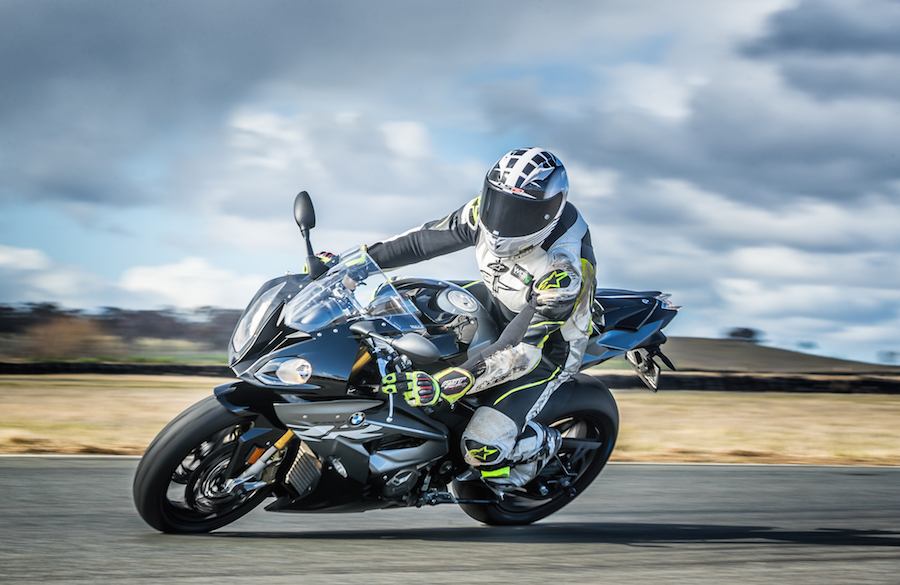
Shawn said it felt fast, and that point was proved at the drag strip where it went into the 9s consistently. It also clocked the best time, and the highest top speed. The engine is electric smooth and fuller than the previous generation that had no bottom end, making it a much easier bike to ride than before.
The electronics package was, if not the best, then an equal winner, with a wide variety of control that still allows you to disengage ABS and traction control with the push of a button – just in case you want to do some old-school tricks. It’s also fitted with Shift Assist Pro, which allows clutchless up and down shifts just like a racebike and adds that factory racer feel we are all searching for.
It’s the pick of the bunch on the freeway too, with the heated grips and easy-to-use cruise control making long hauls much less of a chore than they normally are on a race replica. But it’s BMW’s addition of Dynamic Damping Control that pulls the package together.
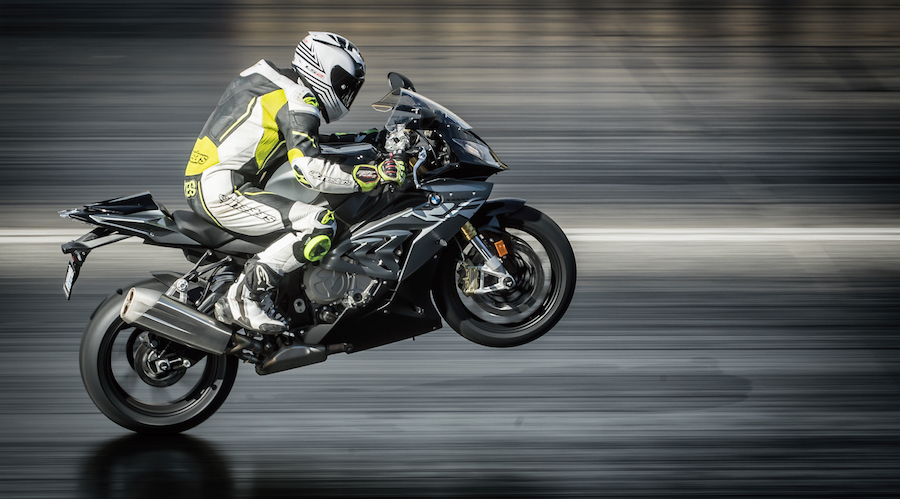
The Sachs-developed system uses a valve arrangement that opens and closes the diameter of the valve in the front and rear suspension, providing a massive range of adjustment for the rider. You could ride to the track in super-soft comfort mode, touch a button to stiffen it up and be ready for your trackday. Not bad…
When it comes to value for money the BMW sits high on the list – it’s got a lot of strong points, but being a couple of years old it has fallen behind a little too. Although the dash is perfectly functional, it isn’t as trick as the TFT versions on some of the other bikes, but that’s a small price to pay for such a good machine.
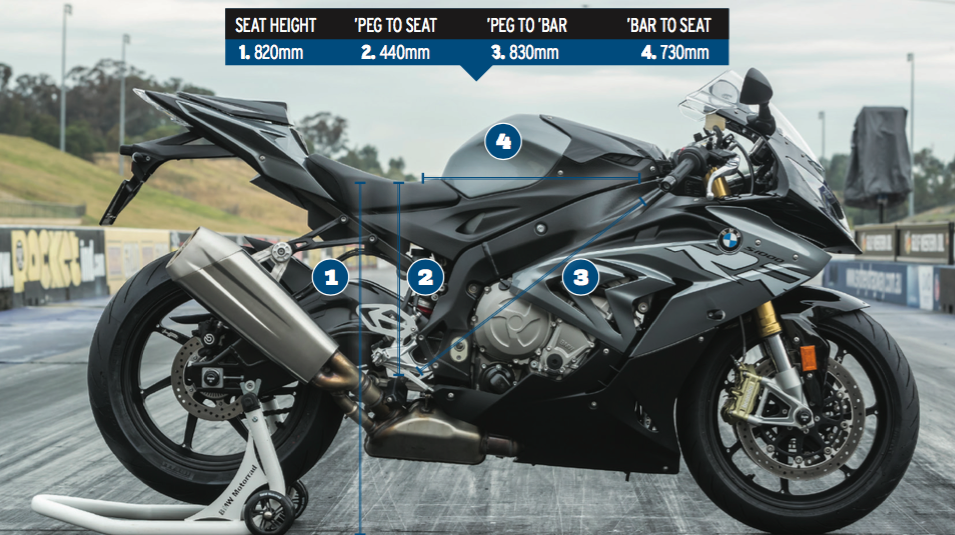
Three things
- A face only a mother could love? Not many of our testers fell for the BMW at first sight, but it really grew on them
- As far as standard mufflers go, the BMW’s stock can was the prettiest of the bunch
- It ain’t TFT, but it’s easy to read when you’re hammering down Wakefield’s straight at over 220km/h

Price $25,690
Power 136.89kW
Torque 110.22Nm
Second Ops
Damien Pelletier
I set my fastest time on the S1000RR, and found it to be one of the easier bikes to lap consistently quickly on thanks to its combination of neutral chassis, strong brakes, smooth engine and spot-on electronics.
The chassis was sweet-steering and made it easy to change direction; it tipped into corners with zero effort while still maintaining mid-corner stability.
The screaming engine offered smooth power over the rev range, with the great fuelling giving me confidence and making it a thrill to ride. The fact it’s got heated grips and cruise control is a bonus.
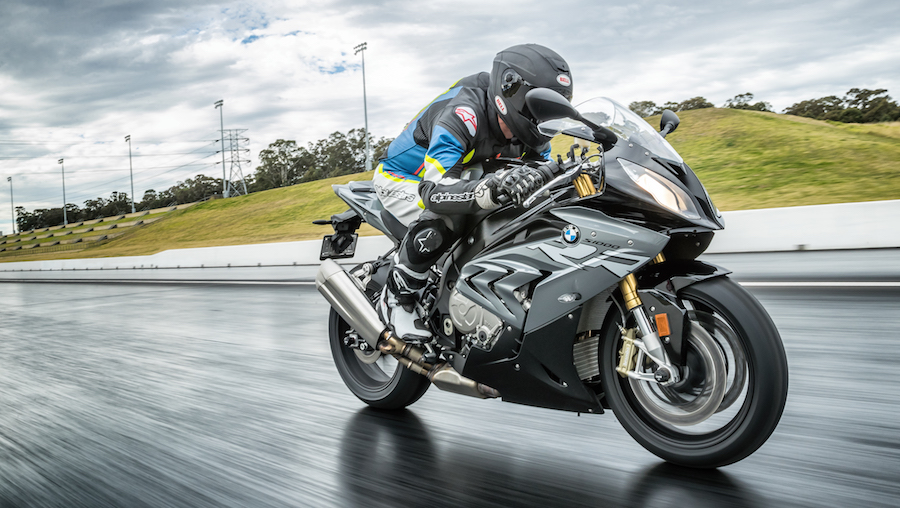
Harley from RB Racing says…
As flawless as the S1000RR feels on the road, the power curve doesn’t quite match it. The torque wavers a bit around 6000-8000rpm, and the fuelling gets rich above 11,000rpm, causing dips in power. But the engine feels smooth and strong, and the auto up-and-down quickshifter is one of the best I’ve tested. It’s already the most powerful four-cylinder bike on test, and the addition of an aftermarket tuning device and a good tune would make it a very potent package.


2017 AMCN AUSTest
Once it was the kind of cutting-edge technology you’d find only on MotoGP and WSBK bikes; now electronic assist systems and dynamic suspension are the rule for all big-bore production superbikes, not the exception.
In our last AUSTest, back in 2015, we celebrated the rebirth of the superbike, when the world’s top manufacturers pulled themselves out of the GFC doldrums and got back to work creating proper one-litre speed machines. Bugger the cost, and bugger the practicality they said.
Two years later, the world’s fastest and most desirable machines have morphed once more. With big-bore nakedbikes becoming the machine of choice for the regular rider wanting usable power, handling and looks in a package they can live with day to day, production superbikes have become the Ferraris and Lamborghinis of the motorcycling world. Crammed full of power, performance and electronics few will ever fully test, and riding on a suspension package that can adjust itself on the fly, these machines are gorgeous examples of what is possible, yet are impractical for the road – and that’s why we love them.
In another first for AUSTest, every bike tested this year sits well over the $20,000 mark. If your five-figure budget begins with a 1, you are out of luck. All that technology comes at a cost, but as you are about to discover, a higher price mostly offers better value for money.
While the evolution of the superbike has continued unabated, one thing returning to the way of old is how we conduct AUSTest. For 2017, we were back in NSW and invited manufacturers to be hands on, requesting each deliver their bike accompanied by a factory-trained technician to help our test riders find the best possible set-up. Such is the high regard the manufacturers have for the AUSTest title, most sent multiple staff and the show looked more like a round of the ASBK than a shootout. That’s fitting, considering our AUSTest combatants often go head to head on the track.
In the end, there can be only one winner, and over the next 26 pages we will take you through the exhausting testing process. Then, when you think you have the winner sussed, we will reveal our champion. Enjoy the ride – we certainly did.
And the winner is…..
Four days, six bikes, eight riders and nine categories of scoring saw our closest ever AUSTest result. The top two bikes were separated buy just two points with Suzuki’s brand new GSX-R1000R coming so close to taking the crown and Honda’s CBR nipping at its heels. Each and every one of the bikes on test excelled in different areas, but in the end it came down to the best all-rounder … and that was the BMW.
It’s not the first time that the Beemer has taken the AUSTest crown – it won back in 2011 with its then spectacular top-of-the-range HP4. It’s a credit to BMW that after three years of cosmetic and only minor technical upgrades, it has been able to come out on top, especially against the brand-new competition hitting the market this year from Honda and Suzuki.
It didn’t win in every area though, lacking the emotional attachment of the Ducati or Aprilia, and from the front its lopsided face is one that will grow on the crowd rather than wow them at first sight. What it did have was an everyday easy-to-live with nature that at the flick of a button could turn it in to an animal wanting to rip the bitumen to shreds or keep it to a sedate hundred-horsepower pussycat. It also had the most fuss-free electronics package, letting our guys (and girl) enjoy the ride more than worrying about modes or trying to adjust the buttons all day long. It’s a proven product, has an excellent reliability record and – the knock-out punch – everyday usability. If you had to cruise up the freeway in the rain the Beemer is the one you would take. The design team put a lot of thought into this aspect and its one that counts in this modern world.
Among our team of voters, the Beemer won hearts for its uniqueness. It was the only bike fitted with heated grips, and a traction control and race ABS system that could be easily turned off. Hang on, the Aprilia has cruise too, right? Well yes, it does, but on the freeway it was a fiddle to make it work. Perhaps if we were able to spend more time with the bike things would be different. The Yamaha came a close second in its use of technology with our computer nerds loving the inbuilt data collection system it sports, but it wasn’t enough to get it over the line this year.
It’s worth mentioning that nearly every rider in our AUSTest team chose a different bike to have in their garage. We also came to the conclusion that when you buy one of these hyper-expensive superbikes, practicality and common sense rarely come into the equation. The comprehensive voting scheme gave the BMW the win, but not by enough to count out the others as real contenders when you get your wallet out.
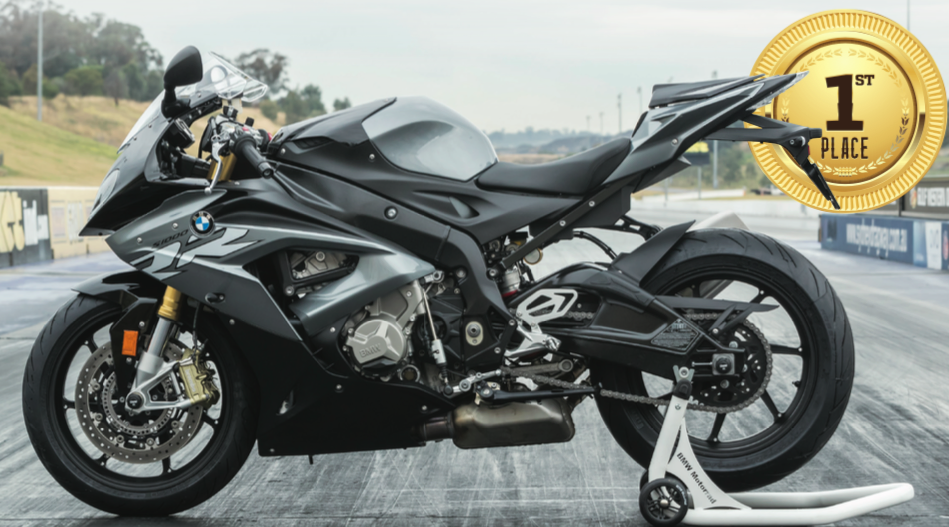
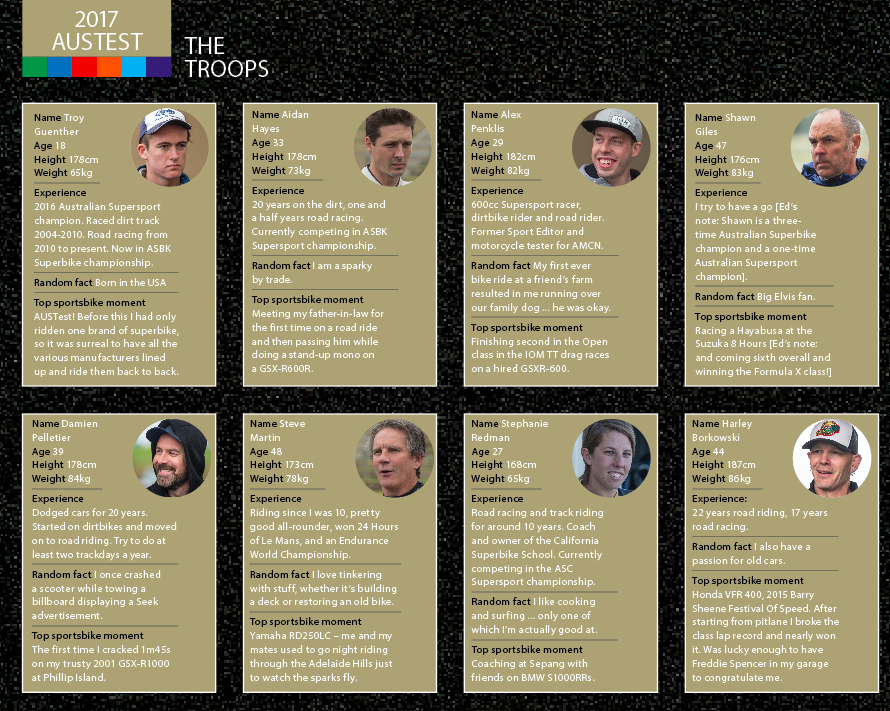
Day 1
Sydney Dragway
It’s a known fact that there’s no quicker way to get away from the lights than to use a machine producing in excess of 130kW and weighing just 200kg. Now, imagine a set of traffic lights where you don’t need to shut the throttle before changing to second gear and obliterating the speed limit. Such a place exists at Western Sydney. With a surface as sticky as shit on a blanket, and electronic timing with reaction times and speed traps, it’s a quarter mile of international-standard heaven that hosts some of the fastest drag bikes and cars in the world.
We lined our six AUSTest combatants up two at a time to test their launch and wheelie control, and of course, to see which could cover the quarter mile distance in the quickest time at the fastest speed. Before getting underway, those in the know said that a low 10-second pass would be impressive.
What eventuated left the experts gobsmacked.

Day 2
Wakefield Park Raceway, Goulburn
A regular stop on the ASBK circuit, Wakefield Park is tight and technical – an evil-handling bike will quickly be found out on the undulating 2.2km circuit. Throw in strong winds and unpredictable weather, and you need to be on the ball.
For a full day we rotated the six AUSTest bikes through the hands of the eight track-test riders. As conditions improved, and the technicians fine-tuned the bikes, the lap times began to drop. While there are no AUSTest points on offer for the fastest lap, there are definitely bragging rights, and everyone wanted them.
We won’t spoil the surprise, but we will say that the lap times set would have seen our stock-standard AUSTest entrants line up mid-grid at an ASBK round. Impressive stuff.
Day 3
Road ride, Goulburn to Sydney
The chosen route was 400km-plus of tight twisty and open country road special stages connected by freeway hops, all packed into a non-stop day. This provided the riders with a chance to sample each bike in the environment where it will be most used. An uncomfortable seating position or snatchy fuelling will always be revealed on a road ride. AUSTest titles have been won and lost in this section of the test.
Day 4
On the dyno
Are the claimed numbers bullshit? There is only one way to find out: with a dyno.
Our final destination for AUSTest 2017 was RB Racing at Caringbah where Harley Borkowski ran each of the bikes on the dynamometer to measure kW and Nm output. Harley was also one of our test riders this year, giving him the unique opportunity to see if the dyno numbers correlated to what the seat of his pants said.
THE METHOD
Who buys a superbike? A snapshot of the current superbike buying public will reveal possibly one of the widest demographics of any genre. Everyone from riders graduating from a restricted licence through to those who have worked long and hard enough to afford a few luxuries in life are buying superbikes. Highly skilled riders and racers buy them, as well as people who just want to look like Messrs Márquez, Rossi and Lorenzo at the local café – and drool over what a production superbike has to offer. AUSTest is as much about real-world performance and looks as it is about race pedigree and lap times, so we assembled a group of riders that represent the broad spectrum of superbike buyers. Daily riders, trackday junkies, endurance champs, national-title winners, professional test riders and young guns presently contesting the national Superbike and Supersport categories all made up the eight-rider test team charged with the task of determining who made the best two-wheeled missile for the best price.
Each rider was given two sessions on each bike on the drag strip, track and the road. Then they were handed an extensive voting form covering everything from how the bike performed and how it made them feel, through to value for money and which bike simply did it for you – regardless
of the cost.
While quarter-mile sprint and track lap times provided an indication of performance as well as plenty of entertainment and all-important bragging rights, it’s the results from the points-based voting sheets that determined the AUSTest 2017 champion.
Tyres
In years past we have experimented with a control tyre for AUSTest. While the idea works in theory, in reality most manufacturers have a commercial agreement with a tyre manufacturer, and the bike is developed using those tyres. If you are a superbike owner keen to cut some serious laps at a trackday, you will be faced with a few brand and rubber compound choices. To simulate a real-world situation, we left tyre choice to the manufacturers. As long as the tyre was DOT approved and available in Australia it was good to go.
Each manufacturer’s choice of tyre for AUSTest is provided on the test results. Most used just the one set of tyres for the drag strip and trackday, reverting to the OEM tyres for the road ride.
Timing
Each bike’s best quarter-mile time and top speed, as well as its fastest lap time on the track, do not form part of the voting criteria for AUSTest 2017, so this information is irrelevant – said no sane motorcycle lover ever. The minute the first bike shot down the quarter mile at Sydney Dragway or turned the first lap at Wakefield Park, everyone had their stopwatch out.
Sydney Dragway has its own timing system, but for Wakefield Park we needed something reliable, easy to install and easy to understand, that provided results instantly. The SpeedAngle lap timer ticked all these boxes. The team from SpeedAngle provided a unit for each bike, and even programmed the name of each model into the system so there could be no mix-ups. All six units performed faultlessly throughout the day, capturing every lap of every session.












